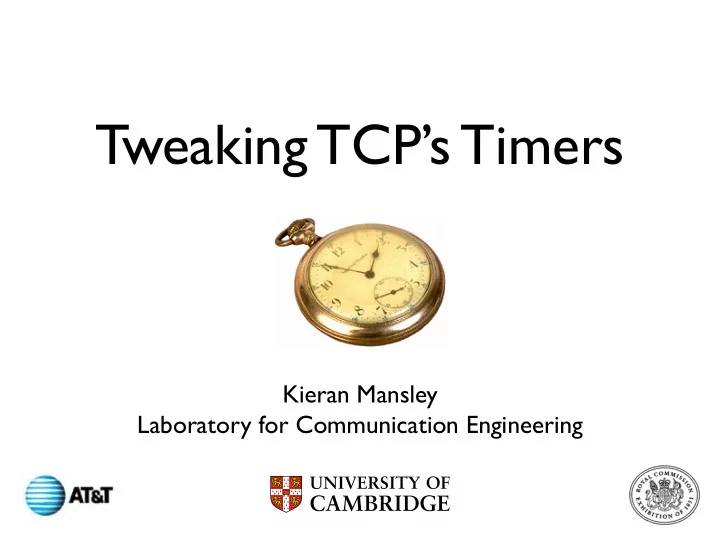

Tweaking TCP’s Timers Kieran Mansley Laboratory for Communication Engineering
Context • Researching user-level TCP for my PhD. • Focusing on how to implement it efficiently at user level, particularly in a server room. • Timers are a small but interesting part of that.
Historical Context • TCP was first specified in the early 1980s • OS support for time was poor and costly • Networks were slower, so time intervals longer. • Portability very important, all leads to... TCP has weak requirements of the OS
What are TCP Timers? • Not measuring time (usually). • Enable an action to be performed later. • Mostly used to deal with inactivity: • Timer set when activity is expected • Timer cancelled when activity occurs • If timer expires, recovery action is executed.
Delayed Acknowledgments • TCP sends acks for reliability and flow control. • Can either be a separate packet or piggyback on a data packet. • Acks are delayed to encourage piggybacking. • Timer used to ensure delay is limited.
Delayed Ack Illustration
Timer Ticks Illustrated
Timer Techniques • How to implement timers? • Trad. scheme based on 100ms clock ticks • Maintain flags in per-connection state. • Each tick, check list of connections for timers. • Modern scheme based on hashed hierarchical timing wheel. • Ordered list of timers, use hardware clock to trigger the check and schedule operation.
Problems • Inaccurate delay of acks: from 0ms to 200ms • List of connections must be searched each clock tick. • A busy connection will still regularly send separate ack packets.
Potential Solution (i) • Change profile of delay:
Potential Solution (ii) • Use two timer buckets to achieve delay limits: Target Bucket A Target Bucket B x x+100 x+200 x+300 x+400 time (ms) Min Max Empty Bucket A x x+100 x+200 x+300 x+400 time (ms) Empty Bucket B
Potential Solution (iii) • Implementation of buckets: • Lazy switch avoids need for scheduling. • Timer execution when blocking op encountered. • Data thread used for active connections. • Time checking done using “rtdsc” counter.
Potential Solution (iv) • Handle timers for active connections from the data thread. • Removes need for locking, other than for handing connections between threads. • No list searching, but... • Increased set/clear timer complexity.
CPU Usage Tradeoff 10 CPU to iterate list (%) measured inline 0.0000754x + 0.0001191 CPU to iterate list (%) measured with ’time’ 0.0000692x + 0.001060 CPU for bucket scheme (%) 1 0.1 CPU usage (%) 0.01 0.001 0.0001 10 100 1000 10000 100000 Connection list size
Summary • Timers at user level can benefit from a different solution. • Change the way timers are implemented to: • Give guaranteed lower, reduced upper bound; • Avoid locking by checking timers in data thread. • Minor performance issue for current TCPs • May be more important in future.
Questions/Comments? Kieran Mansley kjm25@cam.ac.uk http://www-lce.eng.cam.ac.uk/~kjm25 Available as technical report CUED/F-INFENG/TR.487
Recommend
More recommend